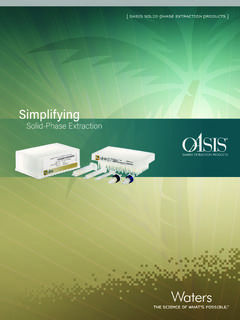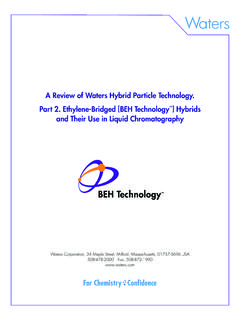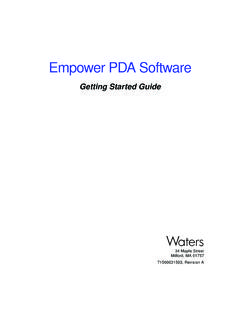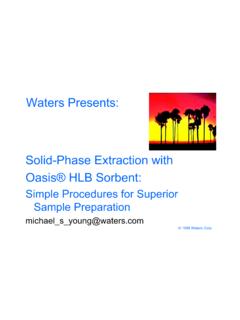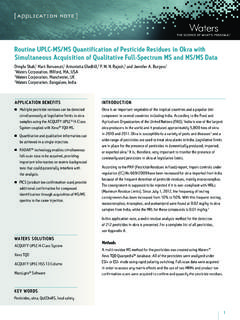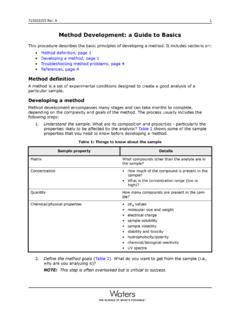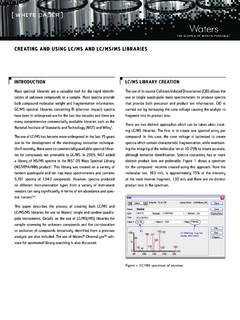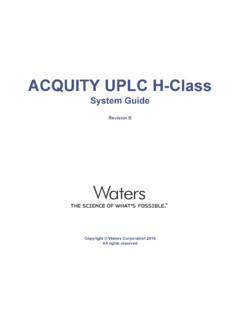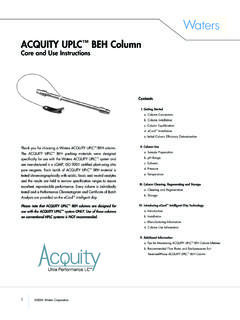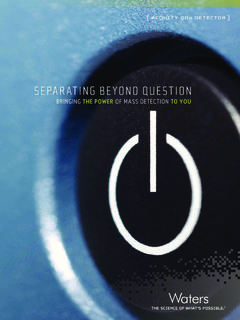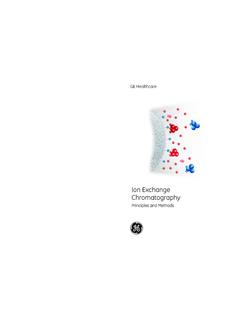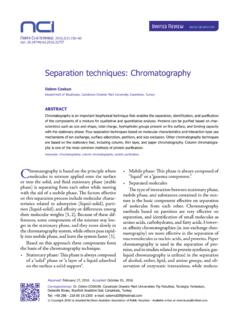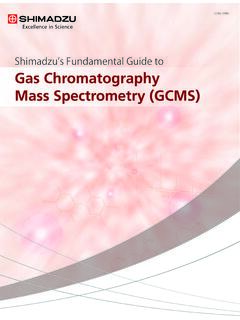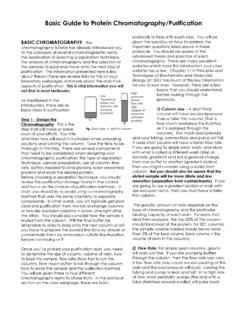Transcription of Waters 2414 Refractive Index Detector
1 Waters 2414 Refractive Index DetectorOperator s Guide71500241402/Revision BCopyright Waters Corporation 2008 All rights reservediiiiiCopyright notice 2008 Waters CORPORATION. PRINTED IN THE UNITED STATES OF AMERICA AND IRELAND. ALL RIGHTS RESERVED. THIS DOCUMENT OR PARTS THEREOF MAY NOT BE REPRODUCED IN ANY FORM WITHOUT THE WRITTEN PERMISSION OF THE information in this document is subject to change without notice and should not be construed as a commitment by Waters Corporation. Waters Corporation assumes no responsibility for any errors that may appear in this document.
2 This document is believed to be complete and accurate at the time of publication. In no event shall Waters Corporation be liable for incidental or consequential damages in connection with, or arising from, its , Millennium, and Waters are registered trademarks of Waters Corporation, and Empower, ExpertEase, LAC/E, PowerLine, SAT/IN, and THE SCIENCE OF WHAT S POSSIBLE , are trademarks of Waters is a registered trademark of Victrex is a registered trademark of Saint-Gobain registered trademarks or trademarks are the sole property of their commentsWaters Technical Communications department invites you to tell us of any errors you encounter in this document or to suggest ideas for otherwise improving it.
3 Please help us better understand what you expect from our documentation so that we can continuously improve its accuracy and usability. We seriously consider every customer comment we receive. You can reach us at WatersContact Waters with enhancement requests or technical questions regarding the use, transportation, removal, or disposal of any Waters product. You can reach us via the Internet, telephone, or conventional considerationsSome reagents and samples used with Waters instruments and devices can pose chemical, biological, and radiological hazards.
4 You must know the potentially hazardous effects of all substances you work with. Always follow Good Laboratory Practice, and consult your organization s safety representative for you develop methods, follow the Protocol for the Adoption of Analytical Methods in the Clinical Chemistry Laboratory, American Journal of Medical Technology, 44, 1, pages 30 37 (1978). This protocol addresses good operating procedures and the techniques necessary to validate system and method contact informationContacting mediumInformationInternetThe Waters Web site includes contact information for Waters locations worldwide.
5 Visit , and click Waters Division > Contact Waters and faxFrom the USA or Canada, phone 800 252-HPLC, or fax 508 872 other locations worldwide, phone and fax numbers appear in the Waters Web mailWaters Corporation34 Maple StreetMilford, MA 01757 USAviSafety considerations specific to the detectorRadiation hazardThe device does not emit any type of hazardous radiation. It emits a minimum amount of electromagnetic radiation that is within the limits of applicable emissions standards (EN61326).Protective groundingThe Detector requires protective grounding for operation.
6 The three-conductor electrical cord that supplies power also grounds the device. This power cord is approved by a Nationally Recognized Testing Laboratory (UL, ETL). It must comprise three, 18-gauge, insulated conductors and be rated for 300 drainage system is installed in the Detector . There is a drip tray inside the unit to catch any fluid from leaks or spills. This tray is connected to an external drain on the bottom of the device. Tubing connected to this drain routes the fluid into an appropriate waste wasteDuring standard operation, this device does not produce any by products or waste.
7 Any waste resulting from a leak or spill is channeled into the drain located on the underside of the device. Tubing connected to this drain directs the flow to an appropriate waste repair or disposalDirect questions regarding repair or disposal to Waters at the address and telephone number given on page i-v. Waters carries out equipment disposal in Europe according to the WEEE directive specific to the country. Waters also accommodates any special requirements for locations outside of advisoriesConsult Appendix A for a comprehensive list of warning and caution this instrumentWhen operating the Waters 2414 Reflective Index Detector , follow standard quality-control (QC)
8 Procedures and the guidelines presented in this symbolsAudience and purposeThis guide is intended for use by individuals who need to install, operate, maintain, and/or troubleshoot the Waters 2414 Reflective Index guide sets forth procedures for unpacking, installing, using, maintaining, and troubleshooting the Waters 2414 Reflective Index Detector . It also includes appendices for safety warnings and use of the Waters 2414 Refractive Index DetectorThe 2414 Refractive Index (RI) Detector is designed for high-performance liquid chromatography (HPLC) applications.
9 It provides sensitivity, stability, and reproducibility for the analysis of components with limited or no UV To calibrate LC systems, follow acceptable calibration methods using at least five standards to generate a standard curve. The concentration range for standards must include the entire range of QC samples, typical specimens, and atypical that a manufactured product complies with all applicable European Community directivesAustralia C-Tick EMC CompliantABN 49 065 444 751viiiQuality-controlRoutinely run three QC samples that represent subnormal, normal, and above-normal levels of a compound.
10 Ensure that QC sample results fall within an acceptable range, and evaluate precision from day to day and run to run. Data collected when QC samples are out of range might not be valid. Do not report these data until you are certain that the instrument performs analyzing samples from a complex matrix such as soil, tissue, serum/plasma, whole blood, and other sources, note that the matrix components can adversely affect LC/MS results, enhancing or suppressing ionization. To minimize these matrix effects, Waters recommends you adopt the following measures: Prior to the instrumental analysis, use appropriate sample pretreatment such as protein precipitation, liquid/liquid extraction (LLE), or solid phase extraction (SPE) to remove matrix interferences.
